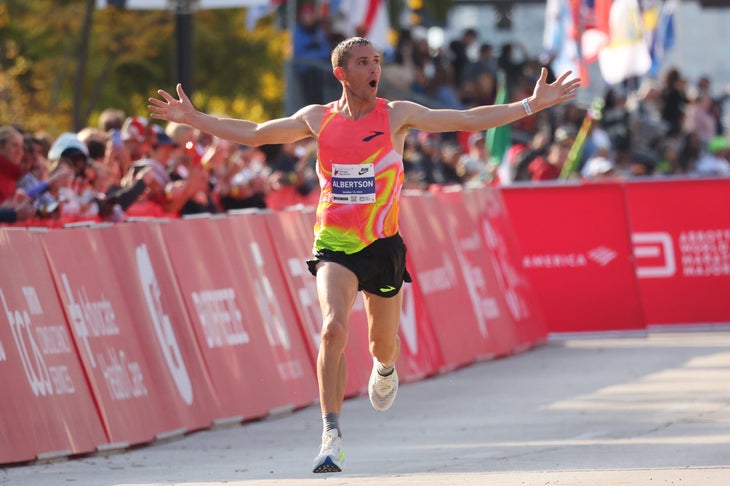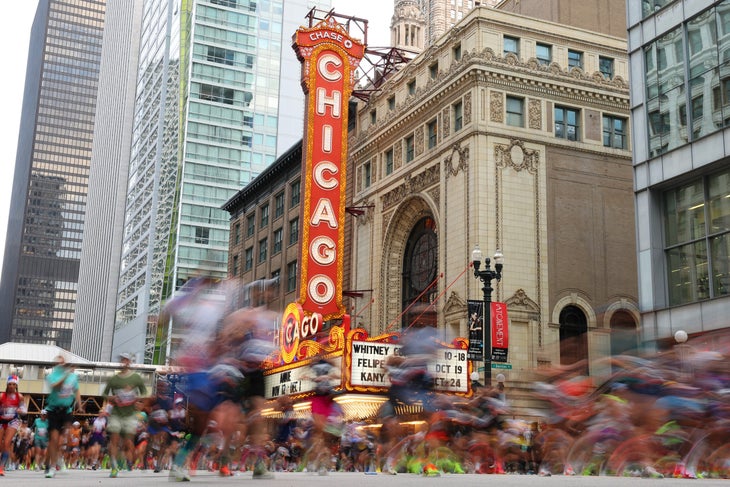New perk: Easily find new routes and hidden gems, upcoming running events, and more near you. Your weekly Local Running Newsletter has everything you need to lace up! Subscribe today.
On Sunday morning at the Chicago Marathon, Ruth Chepng’etich took women’s marathoning into a new dimension.
The 30-year-old Kenyan became the first woman to average faster than 5 minutes per mile for 26.2 miles and break the 2-hour, 10-minute plateau. Her 2:09:56 effort amid breezy but otherwise ideal running conditions shattered the marathon world record of 2:11:53 set just over a year ago by Ethiopian Tigst Assefa at the 2023 Berlin Marathon.
Bolstered by her two male pacers taking her through the halfway mark in 1:04:16—the fifth-fastest women’s half marathon time ever recorded and the fastest ever on U.S. soil—Chepng’etich outran the rest of the women’s field (which included seven sub-2:20 runners) early in the race and slowed only slightly through the second half of the course.
The 2019 world champion in the marathon and previously a two-time winner in Chicago, Chepng’etich dug deep and surged late in the race and again ran under 5-minute pace in the homestretch along South Michigan Avenue, up and over the hill at the 26-mile mark known as “Mount Roosevelt,” and onto the final 200-meter finishing stretch along Columbus Drive in Grant Park to win the Chicago Marathon for the third time in four years.
Chepng’etich not only smashed the world record by nearly 2 minutes, she also shaved more than 4 minutes off her previous personal best of 2:14:18 set en route to winning the Chicago Marathon in 2022.
“I feel so great,” Chepng’etich said in a post-race interview with NBC Chicago. “The world record is my dream, that has now come true. I fought a lot thinking about the world record and now I’ve fulfilled it. I’m so grateful. This year the weather was perfect and I prepared well. The world record was on my mind.”
It was truly a stunning effort that should rank among the best performances ever in the sport of running at large.
For years, breaking 2:15 seemed unthinkable, given that Paula Radcliffe’s 2:15:25 record had remained unchallenged since 2003. But then with the advent of carbon-plated super shoes in 2019, Kenyan Brigid Kosgei finally broke it that year with a 2:14:04 effort in Chicago. It took 16 years to surpass Radcliffe’s record, and only five women have ever done it, but what’s astonishing to think about is that Chepng’etich ran more than 10 seconds faster per mile than Radcliffe’s 5:09 average pace.
Chepng’etich established herself as a solid although not supernatural elite shortly after she started marathoning in 2017, running 2:22:36 that year, 2:18:35 in 2018, and 2:17:08 several months later. She won the world championship marathon in the heat of Doha in 2:32:43 in 2019 before two performances in the 2:22 range at the 2020 London Marathon and 2021 Chicago Marathon. Her meteoric leap began the next year when she punched 2:14:18 on the clock on the same Chicago course—missing the world record by 14 seconds. Last year, she finished second in Chicago (2:15:37) when Sifan Hassan debuted with the second-fastest time in history (2:13:44).
But breaking 2:10 is a whole new realm. Some calculations suggest it’s equivalent to a sub-4-minute mile or running 28:06 for 10,000 meters.
Should her fairytale progression inspire the rest of us to reach for unthinkable heights, too? Does a feat this transcendental feel so out of reach we can’t even relate? Or should we simply be skeptical that elite running is too good to be true?
Having followed elite distance running for decades, I found Chepng’etich’s effort nothing short of astounding—and yes, as is the case with all world records these days and especially those coming from a country with 300 athletes currently serving bans for doping, inherently dubious. But as a recreational runner for just as long, I have to admit it feels pretty distant from my own existence as a runner and am not really sure how to process it.

What Ruth Chepng’etich’s Marathon World Record Means
How fast is 2:09:56? Chepng’etich averaged 4:58 per mile for the entire race, more than 4 seconds per mile faster than Assefa’s previous world record and 17 seconds per mile faster than Chicago runner-up Sutume Asefa Kebede of Ethiopia, who was a very distant second on Sunday in 2:17:32.
While Kebede’s time is still a world-class effort (and nearly a minute ahead of Emily Sisson’s 2022 American record on the same course), it means she still had about a mile and a half to go when Chepng’etich crossed the finish line.
While it’s impossible and impractical to compare times from other races on different courses—because of different weather, levels of competition, and racing scenarios—Chepng’etich’s time is a transcendent leap for women’s running. It comes in an era that’s seen a dramatic rise in women’s distance running and performances across all sports, and no doubt directly related to the long-overdue increase in funding, support, media coverage and general acknowledgement of women athletes. But men’s times have continued to drop too, which suggests it’s also due to vast improvements in critical variables like training, shoe technology, and high-carb fueling.

But Chepng’etich effort is still an enormous outlier. How fast was she? Take it from CJ Albertson, the top American men’s finisher in Chicago on Sunday, who was seventh in a new personal best of 2:08:17. Averaging 4:54 per-mile pace, Albertson eclipsed his previous best time of 2:09:53 to finish about 90 seconds ahead of Chepng’etich.
“It makes me, personally, feel a little bit slow, but it was awesome,” Albertson said. “Ruth was literally right behind me for a lot of the race, and I thought, ‘I think I’m running pretty fast.’ So obviously she was doing something really amazing.”
How Ruth Chepngetich Set the Marathon World Record
So how did Chepng’etich do it? She said before and after the race that several things inspired to go after the world record in Chicago. That included being disappointed by her second-place finish last year, when Sifan Hassan outran her and disrupted a chance for Chepng’etich third straight Chicago win. Chepng’etich also said she was inspired to honor the legacy of Kelvin Kiptum, who set the men’s world record of 2:00:35 last year in Chicago but was tragically killed in a car accident on February 11 in Kenya.
Kiptum’s record showed what is possible on the Chicago course, given that he ran a staggering negative split (1:00:48 for the first half, 59:47 for the second half) during his world-record run last year. Chepng’etich did not negative split her race on Sunday (her splits were 1:04:16/1:05:40) the way Aseffa did in Berlin (1:06:20/1:05:33), but she certainly didn’t slow down much like many fast-starters do.
Furthermore, Chepng’etich was disappointed not to be selected for Kenya’s Olympic team in Paris this year. She was also coming off a lackluster ninth-place, 2:24:36 showing at the London Marathon in April, so she had plenty of motivation for which to make amends and re-establish herself as one of the top marathoners in the world. Her daughter, 13-year-old Sharleen, is always a big motivational factor, too.
On top of that, the Chicago Marathon rivals the Berlin Marathon and the London Marathon as a world-class race with one of the fastest courses in the world. It’s almost entirely flat—the elevation gain and loss over the duration of the course are a miniscule 243 feet—with the only real hill coming at the very end. And like London and Berlin, elite pacesetters are allowed in both the men’s and women’s races to optimize the opportunity for records to go down.
Carbon-plated super shoes, which have been a big contributor to faster marathon times since 2017, also no doubt played a huge role in Chepng’etich’s effort. She wore a pair of bright yellow Nike Aphafly 3 shoes, the same shoe that Kiptum wore en route to his world record. The 6.2-ounce maximally cushioned shoe with a carbon-fiber plate embedded in the midsole has not only produced extremely fast times and taken runners to the podium of numerous marathons over the past year—Hassan also wore a pair en route to winning the women’s Olympic marathon in Paris—but it’s also received top performance reviews from wear-test teams, including from the Outside Lab results of 2024’s top marathon racing shoes.
The role of super shoes cannot be underestimated, and neither can recent advancements in training and fueling. While the specifics about either of those aren’t readily available in the immediate afterglow of her record-setting victory, it is known that Chepng’etich mostly trains alone and with other male workout partners in the Ngong Hills southwest of Nairobi, Kenya. When it comes to fueling, the science of sports nutrition—especially mid-race fueling—has advanced greatly in recent years as now most marathon runners are taking in as many as 90-120 grams of carbohydrates per hour via gels and the liquid nutrition in their bottles along the course.
But perhaps the biggest thing that Chepng’etich accomplished on Sunday is to once again prove running cannot be not limited by preconceived notions based on the past. In the past two years, we’ve seen Kenya’s Faith Kipyegon break the so-called 3:50 barrier in the 1500 meters (3:49.04) and Beatrice Chebet become the first women to run faster than 29 minutes in the 10,000 (28:54.14). Chepng’etich effort is an even more profound example of what’s possible, not only for elite women runners but also for any age-grouper runner—woman or man—who might have preconceived notions of what they are capable of running for 26.2 miles, or any distance.
The Dark and Bright Sides of Distance Running
Sadly, but also justifiably, the question that always comes up after a distance running world record is broken is whether the eye-popping results have been fueled by performance-enhancing drugs.
I am not suggesting Chepng’etich is a doper or that her record is tainted. And nor am I suggesting that about John Korir (who slashed more than 2 minutes off his personal best to win the men’s race on Sunday in 2:02:44) or the late Kiptum, for that matter, just as I wouldn’t cast aspersions on Albertson, Zach Panning (2:09:16), Reed Fischer (2:10:14), Susanna Sullivan (2:21:56), Lindsay Flanagan (2:23:31) or any other runners who set a new personal bests in Chicago on Sunday. I believe that we’re in a time when advances in training, fueling, and carbon-plated super shoes have made significant impacts to distance running, both for the top-tier elites and everyone else who toes the starting line.
I want to trust that the powers that be—specifically the World Anti-Doping Agency, the U.S. Anti-Doping Agency, and the Chicago Marathon—are diligently enforcing anti-doping regulations through rigid both out-of-competition and pre- and post-race testing. But I’d be a fool to ignore the fact that competitive distance running has a pretty serious doping problem that hasn’t ever been fully addressed or that Kenyan runners and Athletics Kenya have been in the crosshairs of some of the biggest busts over the past decade—including suspended 10,000-meter world record holder Rhonex Kipruto, disgraced 2021 Boston Marathon winner Diana Kipyokei, and former marathon record holder Wilson Kipsang.
Within hours of Chepng’etich’s record-setting win, social media posts and message boards lit up with skepticism and accusations about the legitimacy of her performance.
This skepticism largely felt in the running community is in part due to the fact that she’s represented by Italian agent Federico Rosa, who formerly managed three-time Boston Marathon winner and two-time Chicago winner Rita Jeptoo and 2016 Olympic marathon champion Jemima Sumgong before both were scratched from the record books for testing positive for EPO. Kenyan officials were also investigating Rosa for harming professional athletes through doping, although those charges were dropped.
After Steve Magness, the former assistant coach and whistle blower at the Nike Oregon Project, praised her performance on X, someone asked if it was too good to be true. He replied: “You want to hope, but given the massive time drop, that her agent is Rosa, etc., if I had to bet, I’d say it’s too good to be true.”

I want to believe, even though I’m also a realist. Unfortunately, the doping problem seems to be conveniently ignored or, worse yet, easily put out of sight and out of mind—especially in the moment when we celebrate world records, big city marathon wins, and global championship races—because drug-testing results and specific positive doping consequences usually take months, sometimes years, to be revealed and adjudicated.
So where does this leave us as committed runners who want to be fans of the sport? That’s honestly hard to say. Distance running has increasingly become a rather peculiar sport, both because the performances of elite runners seem so unfathomable to fans and participants, and also because the competitive side of the sport has become a sideshow to the millions of age-groupers who are mostly interested in their own running. The excitement of marathon running is now clearly somewhere in the middle of the pack, where runners are achieving their own goals, running at “party pace” with friends, raising money for a good cause, or in it for the life-changing moments it delivers to anyone who accepts the challenge.
Watching the race unfold via livestream reminded me of the time as a young runner in the Chicago area as I watched street-side as Steve Jones broke the men’s world record in the 1984 Chicago Marathon. His performance helped spark my own passion for the sport, including running the Chicago Marathon several times. Once again, watching 50,000 runners make their way through the neighborhoods of my favorite city, I felt that spark to go back and run it again—even if I’m not capable of running as fast as I once did—just to feel the magic that a race like that can produce for all levels of runners.
And that’s the essence of marathon running. While running has a robust community, marathon running is really about individual efforts that produce individual results that are more arbitrary than we want to believe. You can be inspired and skeptical about how fast someone runs and be proud of your own results, but you’re never defined by your personal bests or the time on the clock on race day. Your specific results only matter to you, but the shared, purposeful journey of training and reaching a finish line can be shared with the entire running community—even if you’ve trained alone. Ultimately, running is meaningful because of your commitment to training, running experiences with friends, improved mental and physical health, and the reasons you decided to commit to a race in the first place.
So how did I take in Chepng’etich’s otherworldly record? After watching it all play out in Chicago, I laced up my shoes for my own long run, inspired about my next 26.2-mile ramble through the Windy City.
